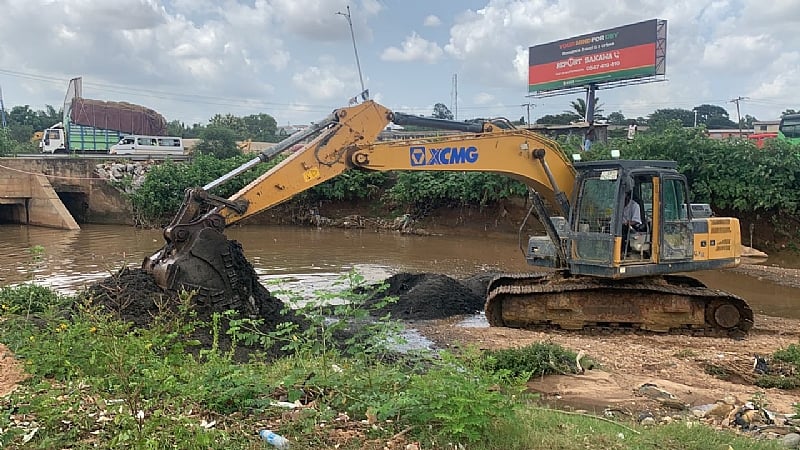The National Disaster Management Organization (NADMO) has embarked on a comprehensive 12-day desilting operation in the Ashanti Region of Ghana, targeting 17 major drains to mitigate the perennial threat of flooding, particularly in the Greater Kumasi area. This proactive measure aims to improve the region’s drainage infrastructure and reduce the vulnerability of communities to the devastating impacts of floods during the rainy season. The operation, which commenced on May 22, 2025, at the Aboabo River near the Airport Roundabout, reflects NADMO’s recognition of the critical need for preventive action rather than solely reactive responses to flood disasters. The initiative is a testament to NADMO’s commitment to safeguarding lives and property by addressing the root causes of flooding in the region. This desilting operation signifies a crucial step towards building a more resilient and flood-resistant Ashanti Region.
The selection of the 17 drains for desilting was based on preliminary assessments conducted by NADMO, which revealed significant blockages due to accumulated silt, solid waste, and debris. These obstructions severely restrict the flow of water through the drainage channels, increasing the likelihood of flooding even during moderate rainfall. Among the targeted areas are the Aboabo River near the Airport Roundabout, the Pelele River at Aboabo, Asabi, and Anloga Junction, all known flood-prone locations within the Ashanti Region. The inclusion of these specific sites underscores NADMO’s strategic approach, prioritizing areas with historically high flood risks and significant population densities. By focusing on these critical drainage systems, NADMO aims to maximize the impact of the desilting operation and provide substantial relief to communities most vulnerable to flooding.
The desilting operation forms a key component of NADMO’s broader strategy to enhance flood management in the Ashanti Region. This comprehensive strategy likely involves a multi-pronged approach, including public awareness campaigns to educate residents about proper waste disposal practices and the importance of maintaining clear drainage systems. Furthermore, it may encompass infrastructural improvements, potentially involving the construction of new drainage channels or the rehabilitation of existing ones to increase their carrying capacity. Collaboration with local authorities and community groups will undoubtedly play a vital role in ensuring the long-term success of these initiatives. By engaging with stakeholders at all levels, NADMO can foster a sense of shared responsibility and create a more sustainable approach to flood management.
Alhaji Ibrahim, the Ashanti Regional Director of NADMO, emphasized the organization’s commitment to partnering with key stakeholders in tackling the pervasive challenge of flooding in the region. He highlighted the importance of collaboration with local communities, government agencies, and other relevant organizations to ensure the effectiveness and sustainability of flood mitigation efforts. The desilting operation, he explained, is a crucial step towards restoring the full capacity of these vital drainage channels, enabling them to effectively manage storm water runoff and minimize the risk of flooding. He stressed that the success of this initiative hinges on the collective efforts of all stakeholders, working together to achieve a common goal of creating a safer and more resilient environment for the people of the Ashanti Region.
Alhaji Ibrahim also confirmed that NADMO had obtained the necessary authorization from the Ashanti Regional Minister, Hon. Frank Amoakohene, to undertake the desilting operation. This official endorsement underscores the regional government’s recognition of the severity of the flood risk and its commitment to supporting NADMO’s efforts to address this critical issue. The provision of an excavator by the regional government demonstrates the tangible support being provided to ensure the efficient and effective execution of the desilting operation. This collaborative approach between NADMO and the regional government signifies a unified front against the recurring threat of flooding in the Ashanti Region.
The desilting operation targeting the Aboabo Nsuo drain, a particularly critical drainage channel severely impacted by accumulated waste and sediment, exemplifies the urgency and importance of this initiative. The narrowing of the drain due to these blockages significantly restricts its capacity to handle stormwater runoff, making it a prime contributor to flooding in the surrounding areas. The ongoing desilting efforts aim to restore the drain’s full functionality, enabling it to effectively manage water flow and mitigate the risk of future flooding. This targeted intervention highlights NADMO’s proactive approach to addressing specific vulnerabilities and prioritizing areas with the highest flood risks. By focusing on critical drainage systems like the Aboabo Nsuo drain, NADMO aims to achieve tangible and impactful results in its mission to protect communities from the devastating consequences of flooding.


